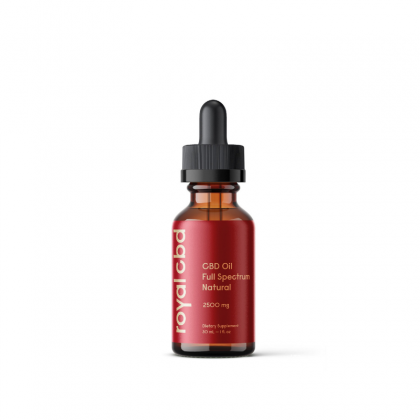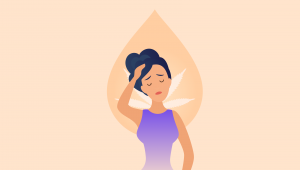| Total CBD: | 500 – 2500 mg |
| Potency: | 16.6 - 83.3 mg/mL |
| Cost per mg CBD: | $0.12 – $0.18 |
| Extract Type: | Full-spectrum |
| THC Content: | <0.3% |

Evidence based
CBD for Osteoporosis: Can Hemp Oil Help Reverse Bone Loss?
Exciting new research has been exploring CBD’s powerful ability to speed fracture healing and preserve bone density.
Learn how it works and how to use CBD products for osteoporosis effectively.
Estimates suggest more than 200 million people have osteoporosis around the world [1].
According to the International Osteoporosis Foundation, osteoporosis is responsible for a staggering 8.9 million bone fractures annually — meaning there’s an osteoporotic fracture roughly every three seconds [2].
Often referred to as a “silent disease,” many people don’t realize they have the condition until a fracture occurs.
Here, we will discuss osteoporosis, current treatment options, and scientific research on how CBD can help.
How Does CBD Help With Osteoporosis?
CBD (cannabidiol) is the primary non-psychoactive compound in cannabis. It’s been shown to support bone metabolism indirectly through its effects on the endocannabinoid system (ECS).
The ECS is a complex network of receptors that work to regulate various aspects of our health — including the formation and degeneration of bone [3]. Through this system, CBD is thought to help reduce bone loss and promote the regeneration of lost bone tissue.
CBD should always be used in combination with other therapies for maximum benefit. CBD is not a cure for osteoporosis, but can offer a powerful supportive role when used alongside other medications, supplements, and exercises.
The benefits of CBD oil for osteoporosis may include:
- May improve the density of bones
- Alleviates pain & inflammation
- Supports hormone balance
- Relieves pain from bone fractures
1. CBD May Improve Bone Density
Research has discovered that CBD appears to enhance the growth and strengthening of bones through accelerated osteoblast formation.
Researchers believe that osteoclasts — the cells that breakdown bone — have a cell receptor that, when activated, speeds up bone loss and degeneration. This receptor is known as GPR55. CBD has been shown to specifically block the activation of this receptor, reducing osteoclast activity [5].
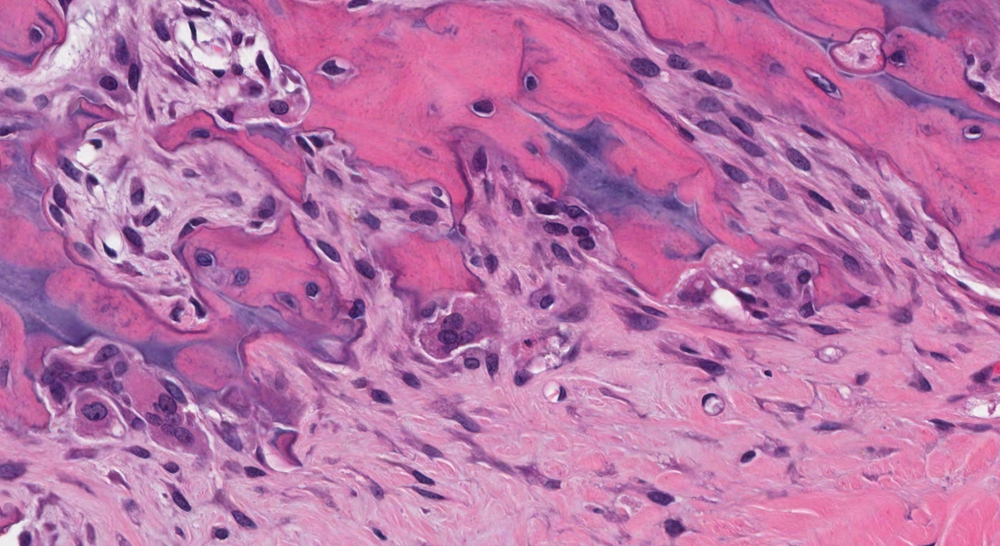
Further, in a recent study in Israel, mice were given CBD or a combination of THC and CBD. The study found that the administration of CBD alone has significant effects on fracture healing with increased bone strength and toughness by stimulating Lysyl Hydroxylase — an enzyme involved in bone healing [5].
This research has given us a deeper insight into how CBD influences the body and opens up some exciting potential for further research.
2. CBD Alleviates Pain & Inflammation
CBD may have a therapeutic role in inflammation and healing. It has long been used by people with chronic pain and offers a non-habit-forming alternative to pain medications.
Many patients have reported replacing their prescription pain medications with CBD, with evidence that its use can help in the treatment of headaches, mental health disorders, insomnia, arthritis, and other chronic pain syndromes [6].
What’s The Dose of CBD Oil For Osteoporosis?
The key is to start low and go slow.
As yet, there are no standardized dosing guidelines for CBD use. CBD oil can come in many different strengths. As products vary greatly, it’s important to read the label of the specific product you are using.
When it comes to managing osteoporosis, the benefits will take several months before any change is noticed. We recommend starting with a moderate dosage (based on your weight using our CBD oil calculator below).
If you experience side-effects (more on this later), reduce the dose until they disappear.
CBD Oil Dosage Calculator
Is CBD Oil Safe?
CBD is safe, even at high doses — but there are a few exceptions to be aware of.
According to the WHO, CBD oil, in its pure state, does not cause harm or have the potential for abuse — even at high doses [7].
If you’re using any prescription medications, or have underlying health issues, you should always speak with your doctor before taking CBD. Certain medications may interact with CBD and lead to side-effects.
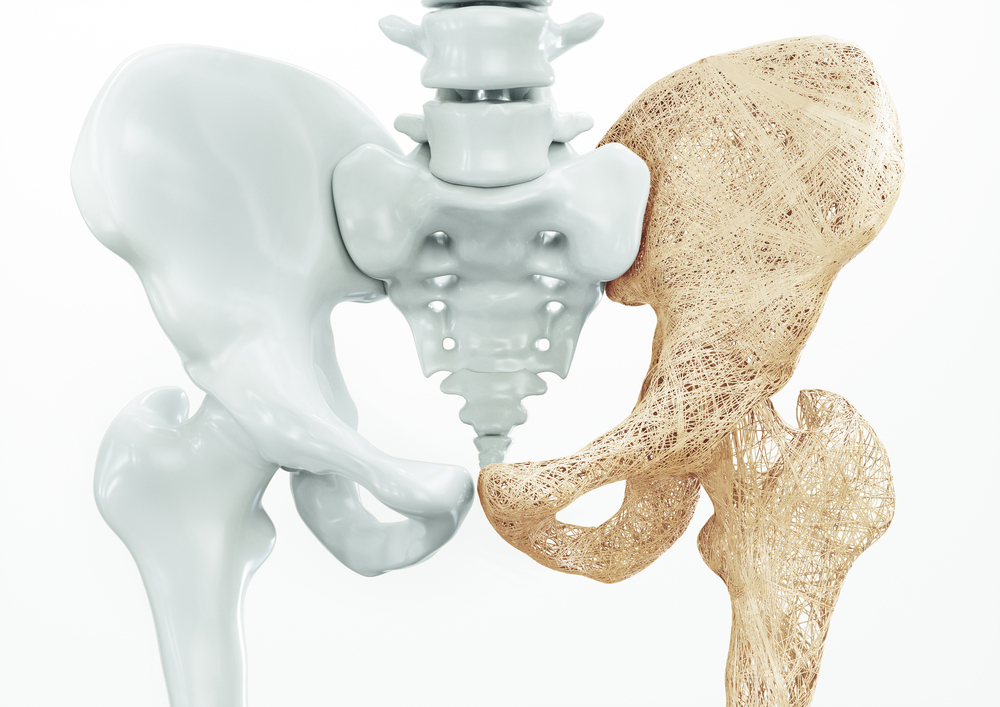
What is Osteoporosis?
Osteoporosis means “porous bones.” It results in fragile bones. The weakness of the bones puts those affected at a higher risk of fractures.
As the bones become thinner, even a minor fall or bump can cause a serious injury.
Middle-aged women are at the highest risk — however, men are also affected.
The main concern most people have when talking about osteoporosis is the high risk of bone fracture. A fracture is a complete or partial break in a bone.
It’s estimated that 50% of women and 20% of men over the age of 50 will have an osteoporosis-related fracture in their lifetime [1].
With osteoporosis, the most common bones affected are the hip, wrists, and spine. Fractures and breaks can lead to chronic pain and mobility issues.
Understanding the Definitions
- Cortical bone — the hard outside layer of all bones and makes up most of your skull and ribs.
- Spongy bone — occurs inside the vertebrae and the ends of the long bones, such as the thigh bones.
- Osteoblasts — specialized cells involved in producing new bones.
- Osteoclasts — specialized cells involved in breaking down bones.
- Bone density — the amount of mineral content in a bone.
Symptoms of Osteoporosis
There are no specific symptoms of osteoporosis — the first sign is usually a bone fracture. There are other symptoms, but these can be difficult to identify.
Other signs and symptoms may include:
- Back pain
- Collapsed or fractured vertebra
- Loss of height
- Stooped posture
- Lowered grip strength
Menopause & Osteoporosis
In osteoporosis, there is a thinning of the cortical bone and reduced bone density and structure in the spongy bone. Menopause is one of the main causes of the condition.
Bone tissue is continuously broken down and replenished. It’s a regular cycle, fluctuating on both a daily and monthly basis — affected by things such as time of day, diet, and season.
Specialist cells within the bones called osteoblasts and osteoclasts are essential for these fluctuations in healthy bones. From birth to adolescence, more bone is formed than broken down.
By the end of adolescence, bone growth has completed. By your mid to late 20s, peak bone mass has been achieved.
The sex hormones estrogen and testosterone have a major role in maintaining healthy bones in both men and women.
In menopause, as estrogen levels drop, the balance of hormones that were working to control bone density begins to fall apart. The result is an acceleration in bone loss. Women can lose up to 10% of their total bone mass within the first five years of menopause.
Risk Factors for Osteoporosis
- A family history of osteoporosis
- Previous bone fractures
- Age — people over 50 are at the highest risk
- Early menopause — before the age of 45
- Weight — being overweight is a major risk factor
- Vitamin D — important in the maintenance of bone tissue
- Calcium intake — calcium is a key mineral in bone architecture
- Lack of exercise — weight-bearing exercises directly lower the risk of osteoporosis
- Smoking (linked with osteoporosis)
- Alcohol intake — over three standard drinks per day increases the risk of osteoporosis [1]
- Medications — such as corticosteroid use
- Medical conditions — such as thyroid problems, celiac disease, chronic liver disease, kidney disease, or rheumatoid arthritis
- Conditions that affect the absorption of nutrients — such as Crohn’s disease, celiac disease, and other inflammatory bowel conditions
Diagnosing Osteoporosis
If osteoporosis is suspected, your doctor will most likely send you for a bone density scan.
This scan is used to measure bone mineral density (BMD). It is usually performed using a dual-energy x-ray absorptiometry (DEXA). This is a non-invasive process where, for 10 to 15 minutes, a machine passes over your body while you lie flat on a table.
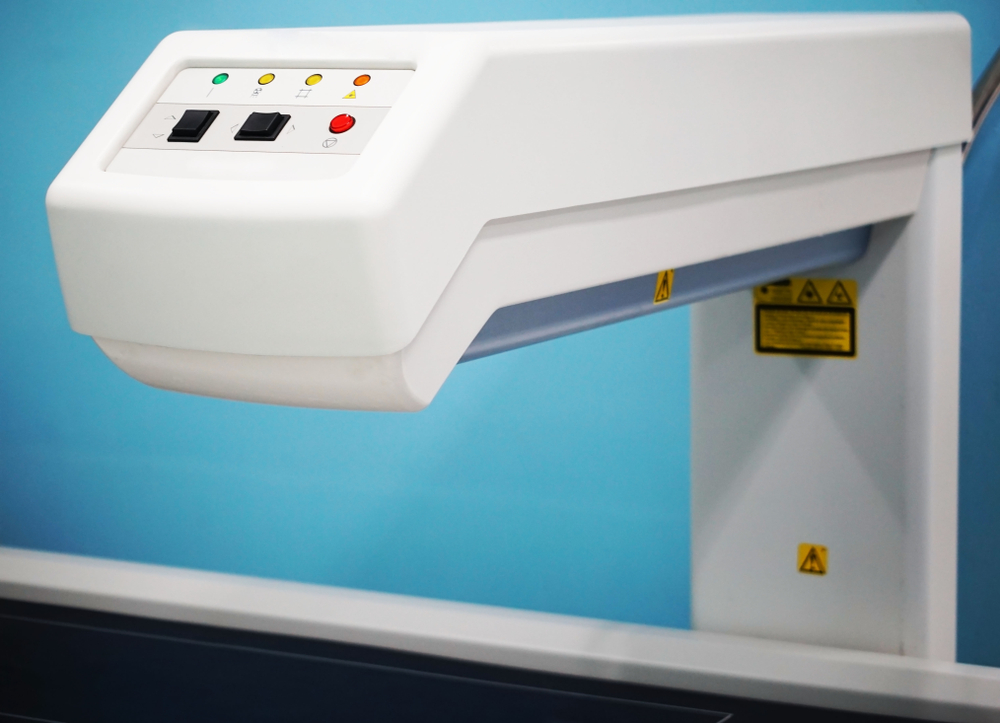
The bone density scan will give you a T-Score and Z-Score, used to determine your risk of developing a fracture and whether further tests are needed.
According to the World Health Organization (WHO), your T-Score is classed as follows:
- -1.0 or above is normal bone density.
- Between -1.0 and -2.5 means you have low bone density or osteopenia.
- -2.5 or below is a diagnosis of osteoporosis.
The following procedures can also be performed to determine bone injury or fractures as a result of osteoporosis:
1. Bone X-Ray
Bone x-rays produce images of bones that aid in the diagnosis of fractured bones, which are sometimes a result of osteoporosis.
2. CT Scan
CT scans of the spine are used to assess alignment and fractures. They can be used to measure bone density and determine whether vertebral fractures are likely to occur.
3. Magnetic Resonance Imaging (MRI)
An MRI of the spine is used to evaluate vertebral fractures for evidence of underlying diseases, such as cancer, and to assess the newness of the fracture.
How is Osteoporosis Treated?
Depending on how severe your osteoporosis is and your risk of bone fracture, your doctor may recommend lifestyle changes to strengthen your bones.
Lifestyle changes can help to ensure both men and women take steps to prevent the risk of developing osteoporosis.
1. Lifestyle & Diet Changes
- Incorporate a varied diet with plenty of fresh fruit, vegetables, and whole grains
- Avoid smoking
- Reducing alcohol intake
- Limit caffeine
- Do regular weight-bearing and strength-training activities
- Ensure adequate vitamin D and calcium intake
However, if your osteoporosis is more advanced, lifestyle changes alone may not be enough to help you strengthen your bones.
Prescription medications are standard care in the treatment of established osteoporosis. Their purpose is to either increase the formation of new bone or slow down the breakdown process.
However, they each come with their own set of side-effects and risks.
2. Bisphosphonate Medications
Bisphosphonates encourage bone density by slowing the breakdown of cells. You can take them with a combination of vitamin D and calcium supplements.
Side-Effects of Bisphosphonates:
- Flu-like reactions
- Stomach upsets
- Diarrhea and constipation
- Joint and muscle pain
- Fatigue
- Jaw pain
- Jaw infection (rare)
3. Selective Estrogen Receptor Modulators (SERMs)
SERMs mimic estrogen in the body, reducing bone loss and increasing bone formation.
Side-Effects of SERMs:
- Hot flushes
- Leg cramps
- Increased risk of blood clots and fatal stroke
4. Denosumab
This is given via an injection under the skin twice a year. It slows down the breakdown of bone, resulting in higher bone mineral density and reduced fractures. It is often used as an alternative to bisphosphonates.
Side-Effects of Denosumab:
- Joint and muscle pain
- Eczema
- High cholesterol
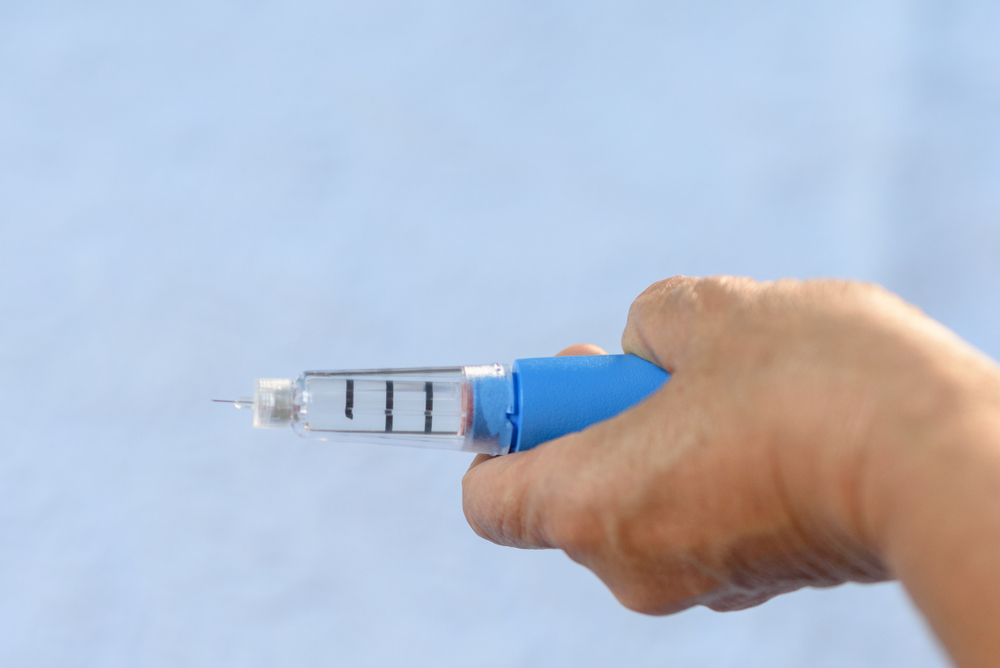
5. Hormone Replacement Therapy (HRT)
Doctors prescribe HRT for women during menopause when there is a drop in estrogen levels, increasing the risk of osteoporosis. However, HRT is no longer routinely recommended due to the increased risks with long-term use.
Side-Effects of HRT:
- Breast cancer
- Heart attack
- Stroke
- Blood clots
6. Testosterone Therapy
When testosterone levels are low in men, doses of testosterone are given by injection to improve bone density.
Side-Effects of Testosterone Therapy:
- Acne and oily skin
- Worsening of sleep apnea
- Increased risk of blood clots
- Increased risk of prostate abnormalities
- Enlarged breasts in men
- Decreased testicular tissue
- Increased aggression, mood swings
- Increased risk of heart disease and stroke (maybe)
Final Verdict: Using CBD for Osteoporosis
Osteoporosis can be a debilitating disease, and the fear of bone fracture can have a significant effect on one’s lifestyle and mobility.
While there is no cure, there is good evidence that CBD may be an effective treatment for osteoporosis by slowing down the progression of the disease and relieving pain.
These are very exciting times, especially as we look at CBD and the clinical research that’s still in its infancy regarding verifying its use in reducing bone loss and fracture.
Based on this information, CBD is seen as a safe, effective, all-natural therapeutic treatment for osteoporosis.
References Cited in This Article
- Sözen, T., Özışık, L., & Başaran, N. Ç. (2017). An overview and management of osteoporosis. European Journal of Rheumatology, 4(1), 46–56. https://doi.org/10.5152/eurjrheum.2016.048
- Enquiries, M. (2008). Facts and Statistics | International Osteoporosis Foundation IOF Facts and Statistics | International Osteoporosis Foundation IOF. International Osteoporosis Foundation, 20, 1–6. Retrieved from https://www.iofbonehealth.org/facts-statistics
- Raphael, B., & Gabet, Y. (2016). The skeletal endocannabinoid system: clinical and experimental insights. Journal of Basic and Clinical Physiology and Pharmacology, 27(3). https://doi.org/10.1515/jbcpp-2015-0073
- Kogan, N. M., Melamed, E., Wasserman, E., Raphael, B., Breuer, A., Stok, K. S., … Bab, I. (2015). Cannabidiol, a major non-psychotropic cannabis constituent enhances fracture healing and stimulates lysyl hydroxylase activity in osteoblasts. Journal of Bone and Mineral Research, 30(10), 1905–1913. https://doi.org/10.1002/jbmr.2513
- Idris, A. I. (2010). Cannabinoid receptors as target for treatment of osteoporosis: a tale of two therapies. Current Neuropharmacology, 8(3), 243–53. https://doi.org/10.2174/157015910792246173
- Baron, E. P., Lucas, P., Eades, J., & Hogue, O. (2018). Patterns of medicinal cannabis use, strain analysis, and substitution effect among patients with migraine, headache, arthritis, and chronic pain in a medicinal cannabis cohort. Journal of Headache and Pain, 19(1), 37. https://doi.org/10.1186/s10194-018-0862-2
- WHO. (2017). WHO | Cannabidiol (compound of cannabis). WHO. Retrieved from http://www.who.int/features/qa/cannabidiol/en/
More Health Benefits to Explore
-
Conditions Related to Health Benefits
- CBD For Allergies: Can This Cannabinoid Ease Symptoms?
- Top 10 CBD Oils For Back Pain
- Can CBD Help With Menstrual Cramps?
- CBD for Sciatica: How It Works, Safety, Drug Interactions, & Best Products
- Is CBD a Viable Treatment for Cerebral Palsy?
- CBD Oil For Sleep
- CBD For Psoriasis: Can CBD Help to Alleviate Symptoms?
- Traumatic Brain Injury (TBI)
- Arthritis
- Anxiety & Depression
- Weight Loss
- ADD & ADHD
- Anorexia
- Alzheimer’s Disease & Dementia
- Addiction
- ALS (Amyotrophic Lateral Sclerosis)
- Antibiotic Resistance
- Asthma
- Atherosclerosis
- Autism
- Acne
- Bipolar Disorder
- Pain
- Crohn's Disease & Ulcerative Colitis
- Diabetes
- Epilepsy
- Endocrine Disorders
- Fibromyalgia
- Fatty Liver Disease
- Glaucoma
- Hypertension
- Heart Disease
- Huntington's Disease
- Inflammation
- Irritable Bowel Syndrome (IBS)
- Kidney Disease
- Migraine Headaches
- Muscle Recovery
- Multiple Sclerosis
- Motion Sickness
- Metabolic Syndrome
- Neurodegeneration
- Cancer
- Nausea
- Neuropathic (Nerve) Pain
- Osteoporosis/Bone Health
- Obsessive-Compulsive Disorder (OCD)
- Polycystic Ovarian Syndrome (PCOS)
- PTSD
- Prion/Mad Cow Disease
- Premenstrual Syndrome (PMS)
- Parkinson’s Disease
- Schizophrenia
- Sickle Cell Anemia
- Stroke
-
Conditions Related to Products
- Ranking The Top 13 THC Gummies By Category (Δ8, Δ9, Δ10, HHC, & More)
- Top 10 CBD Oils For Back Pain
- Everything You Need to Know About CBD Sunscreen
- Top 7 CBD Gummies For Sleep & Insomnia
- Top 7 CBD Gummies To Help With Anxiety (2022)
- Best CBD Gummies For Pain (Top-Rated Pain Gummies For 2022)
- Best Hemp Cigarettes (Top 5 Nicotine-Free Smokes)
- Top 5 CBD Lip Balms For 2022
- The Top 7 CBD Face Masks for 2022
- The Best CBD Inhalers For 2022 (& How to Use Them)
- Best Full-Spectrum CBD Vape Juice: What to Look For & How to Use It
- CBD Eye Drops: New Option For Glaucoma?
- CBD Oil For Dogs With Arthritis
- Best CBD Massage Oils In 2022
- Buyer's Guide To The Best CBD Vape Kits In 2022
- CBD Chocolate: Yes, It Exists & It's Just as Divine as it Sounds
- CBD Pre-Rolls & Cigarettes
- Terpene Concentrates
- Best CBD Soaps
- Best CBD Shampoo & Conditioner
- Best CBD Juul Pods
- CBD Isolate Oils
- Full-Spectrum CBD Oils
- Best CBD Lube
- CBD Honey
- CBD Transdermal Patches
- Best Dry Herb Vaporizers
- CBD Oil For Dogs With Epilepsy
- CBD Oil For Dogs With Anxiety
- CBD Oil For Dogs With Cancer
- CBD For Horses
- CBD Chewing Gum
- CBD Pain Cream
- CBD Oil For Cats
- CBD Oil For Dogs
- CBD Hemp Flower
- CBD Suppositories
- Best CBD Gummies for Pain, Sleep & Anxiety Reviewed (2022)
- CBD Teas
- CBD Vape Pens
- CBD Vape Oils
- CBD Coffee
- CBD Drinks & Shots
- CBD Crystals
- CBD Skincare
- Best CBD Oil & Gummies For Kids: Is CBD Safe for Children with Anxiety & ADHD?
- CBD Concentrates
- CBD Bath Bombs
- CBD Capsules
- CBD Sprays
- CBD Dog Treats
-
Conditions Related to Topicals
-
Conditions Related to Oils & Tinctures
-
Conditions Related to Edibles
- Top 7 CBD Gummies To Help With Anxiety (2022)
- Best CBD Gummies For Pain (Top-Rated Pain Gummies For 2022)
- CBD Chocolate: Yes, It Exists & It's Just as Divine as it Sounds
- CBD Honey
- CBD Chewing Gum
- Best CBD Gummies for Pain, Sleep & Anxiety Reviewed (2022)
- CBD Teas
- CBD Coffee
- CBD Drinks & Shots
- CBD Capsules
-
Conditions Related to Gummies
- Ranking The Top 13 THC Gummies By Category (Δ8, Δ9, Δ10, HHC, & More)
- Top 7 CBD Gummies For Sleep & Insomnia
- Top 7 CBD Gummies To Help With Anxiety (2022)
- Best CBD Gummies For Pain (Top-Rated Pain Gummies For 2022)
- Best CBD Gummies for Pain, Sleep & Anxiety Reviewed (2022)
- Best CBD Oil & Gummies For Kids: Is CBD Safe for Children with Anxiety & ADHD?
-
Conditions Related to Hemp Flower
-
-
Conditions Related to Terpenes
-
-
Conditions Related to Cultivation
-
Conditions Related to Concentrates
-
Conditions Related to Delta 8 THC
-
Conditions Related to Delta 9 THC
-
-
-
-
Conditions Related to CBD
- Everything You Need to Know About CBD Sunscreen
- Top 7 CBD Gummies For Sleep & Insomnia
- Top 7 CBD Gummies To Help With Anxiety (2022)
- Best CBD Gummies For Pain (Top-Rated Pain Gummies For 2022)
- Best Hemp Cigarettes (Top 5 Nicotine-Free Smokes)
- Top 5 CBD Lip Balms For 2022
- The Top 7 CBD Face Masks for 2022
- The Best CBD Inhalers For 2022 (& How to Use Them)
- Best Full-Spectrum CBD Vape Juice: What to Look For & How to Use It
- CBD Eye Drops: New Option For Glaucoma?
- CBD Oil For Dogs With Arthritis
- Best CBD Massage Oils In 2022
- Buyer's Guide To The Best CBD Vape Kits In 2022
- CBD Chocolate: Yes, It Exists & It's Just as Divine as it Sounds
- CBD Pre-Rolls & Cigarettes
- Best CBD Soaps
- Best CBD Shampoo & Conditioner
- Best CBD Juul Pods
- CBD Isolate Oils
- Full-Spectrum CBD Oils
- Best CBD Lube
- CBD Honey
- CBD Transdermal Patches
- CBD Oil For Dogs With Epilepsy
- CBD Oil For Dogs With Anxiety
- CBD Oil For Dogs With Cancer
- CBD For Horses
- CBD Chewing Gum
- CBD Pain Cream
- CBD Oil For Cats
- CBD Oil For Dogs
- CBD Hemp Flower
- CBD Suppositories
- Best CBD Gummies for Pain, Sleep & Anxiety Reviewed (2022)
- CBD Teas
- CBD Vape Pens
- CBD Vape Oils
- CBD Coffee
- CBD Drinks & Shots
- CBD Crystals
- CBD Skincare
- Best CBD Oil & Gummies For Kids: Is CBD Safe for Children with Anxiety & ADHD?
- CBD Concentrates
- CBD Bath Bombs
- CBD Capsules
- CBD Sprays
- CBD Dog Treats
-
-
Conditions Related to THC-O
-
-
Conditions Related to Joint Health
-
Conditions Related to Pain Disorders
- Top 10 CBD Oils For Back Pain
- Can CBD Help With Menstrual Cramps?
- CBD for Sciatica: How It Works, Safety, Drug Interactions, & Best Products
- Traumatic Brain Injury (TBI)
- Arthritis
- Pain
- Fibromyalgia
- Glaucoma
- Inflammation
- Kidney Disease
- Migraine Headaches
- Multiple Sclerosis
- Neuropathic (Nerve) Pain
- Premenstrual Syndrome (PMS)
- Sickle Cell Anemia
-
Conditions Related to Autoimmune Disease
-
Conditions Related to Cognitive Health
-
Conditions Related to Metabolic Disorders
-
Conditions Related to Psychological Disorders
-
Conditions Related to Muscles & Bones
-
Conditions Related to Nervous System
- CBD for Sciatica: How It Works, Safety, Drug Interactions, & Best Products
- Is CBD a Viable Treatment for Cerebral Palsy?
- CBD Oil For Sleep
- Traumatic Brain Injury (TBI)
- Anxiety & Depression
- ADD & ADHD
- Anorexia
- Alzheimer’s Disease & Dementia
- Addiction
- ALS (Amyotrophic Lateral Sclerosis)
- Autism
- Bipolar Disorder
- Epilepsy
- Huntington's Disease
- Inflammation
- Migraine Headaches
- Multiple Sclerosis
- Motion Sickness
- Neurodegeneration
- Neuropathic (Nerve) Pain
- Obsessive-Compulsive Disorder (OCD)
- PTSD
- Prion/Mad Cow Disease
- Parkinson’s Disease
- Schizophrenia
-
-
Conditions Related to Reproductive Health
-
Conditions Related to Hormones & Endocrine
-
Conditions Related to Skin Health
-
Conditions Related to Cardiovascular System
-
Conditions Related to Digestive System
-
Conditions Related to Genetic Disorders
-
Conditions Related to For Children


